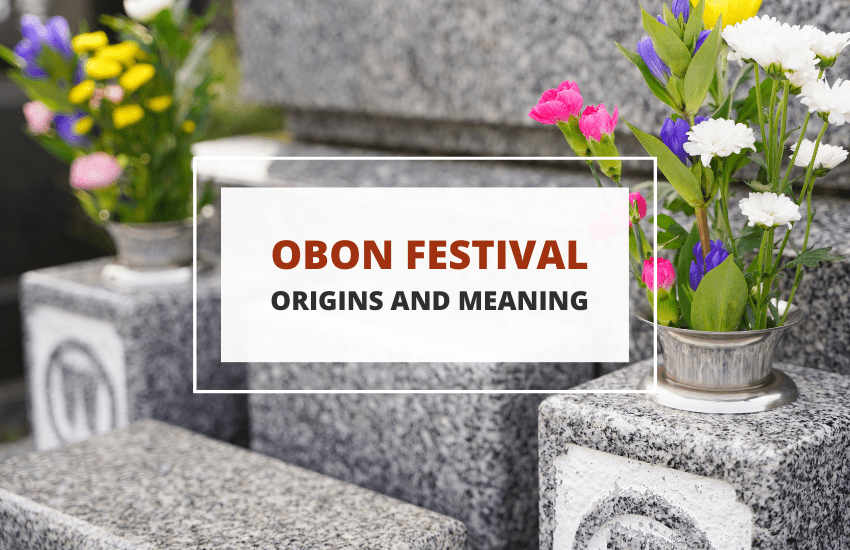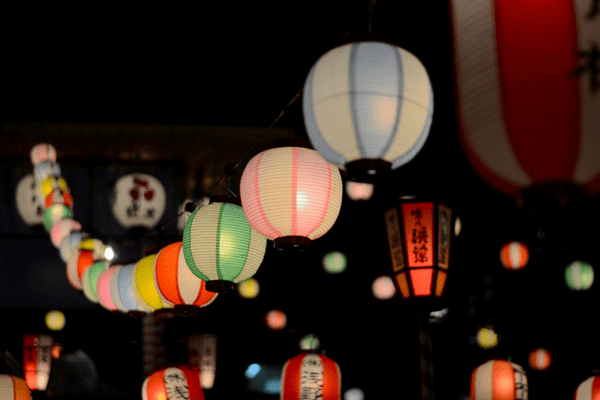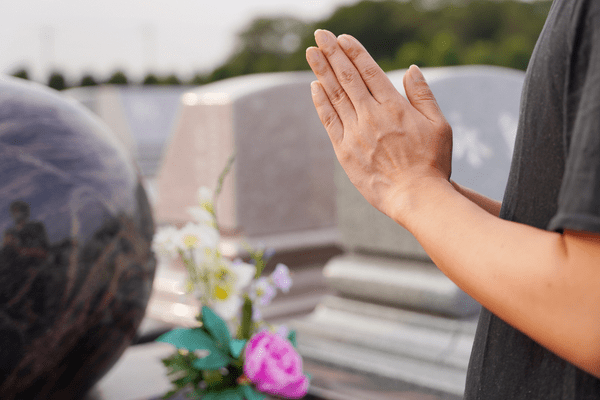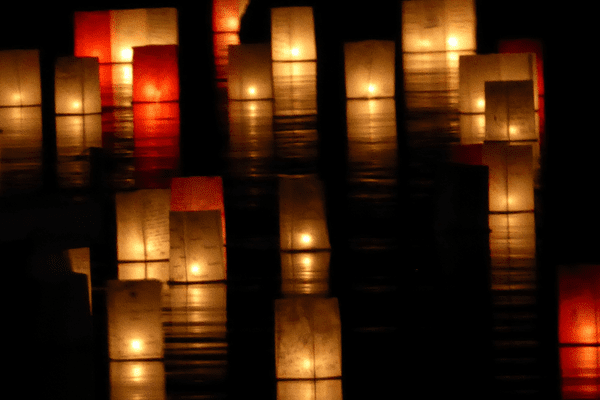
Table of Contents
The Obon festival is a traditional Buddhist holiday commemorating one’s deceased ancestors and paying respects to the dead. Also known as “Bon”, this holiday lasts for three days and is considered one of the three major holiday seasons in Japan, along with New Year and Golden Week.
It is an ancient festival that started as far back as 500 years ago and is rooted in the Buddhist ritual called the Nembutsu Odori. It mainly involves dances and chants to welcome and comfort the spirits of departed ancestors. The festival also incorporates elements from the Shinto religion native to Japan.
Origins of the Obon Festival
It is said that the festival started from a Buddhist myth involving Maha Maudgalyayana, a disciple of the Buddha. According to the story, he once used his powers to check on the soul of his deceased mother. He discovered that she was suffering in the Realm of Hungry Ghosts.
Maha Maudgalyayana then prayed to Buddha and received instructions to make offerings to Buddhist monks returning from their summer retreat. This occurred on the 15th day of the seventh month. Through this method, he was able to free his mother. He expressed his happiness with a joyful dance, which is said to be the origin of the Obon dance.
Obon Festival Celebrations Around Japan
The Obon festival is celebrated on separate dates around Japan due to the differences in the lunar and solar calendars. Traditionally, the festival starts on the 13th and ends on the 15th day of the seventh month of the year. It is based on the belief that spirits return to the mortal world during this period to visit their relatives.
Based on the old lunar calendar, which the Japanese had used before adopting the standard Gregorian calendar in 1873, the date of the Obon festival falls in August. And since many traditional festivals have retained their original dates before the switch. The Obon festival is mostly celebrated in mid-August in Japan. This is called the Hachigatsu Bon or Bon in August.
Meanwhile, the Okinawa, Kanto, Chugoku, and Shikoku regions celebrate the festival every year exactly on the 15th day of the seventh month of the lunar calendar, which is why it is called the Kyu Bon or Old Bon. On the other hand, Eastern Japan which includes Tokyo, Yokohama, and Tohoku, follows the solar calendar. They celebrate Shichigatsu Bon or Bon in July.
How the Japanese Celebrate the Obon Festival

While the festival is rooted in religious rites for the Japanese, it also functions as a social occasion these days. Since this is not a public holiday, many employees will take time off from work to return to their hometowns. They spend time at their ancestral homes with their families.
Some would make adjustments to their lifestyle, such as eating only vegetarian food during the festival period. Modern practices also include gift-giving as a way to express gratitude to those who have shown them care, such as parents, friends, teachers, or colleagues.
Nevertheless, there are still a few traditional practices that are observed nationwide. Though the actual execution may vary from one region to another. Here are some of the standard activities during the Obon festival in Japan:
1. Lighting Paper Lanterns
During the Obon festival, Japanese families would hang paper lanterns called “chochin” or light large fires in front of their houses. And they perform the ritual “mukae-bon” to help the spirits of their ancestors find their way back home. To end the festival, perform another ritual, called “okuri-bon”, to guide the souls back to the afterlife.
2. Bon Odori
Another way of celebrating the festival is through the Obon dances called the Bon odori, or the dance to the ancestors. Bon Odori was originally a Nenbutsu folk dance that is often performed outdoors to welcome the spirits of the dead.
Interested viewers can watch the performance at parks, temples, and other public places around Japan. The dancers would traditionally wear yukatas, which is a type of light cotton kimono. They would then move in concentric circles around the yagura. And in the raised platform where taiko drummers keep the beat going.
3. Haka Mairi

The Japanese would also honor their ancestors during the Obon Festival through “Haka Mairi”, which directly translates to “visiting the grave”. At this time, they would wash their ancestors’ graves, then leave food offerings and light a candle or incense. While this can be done at any time during the year, it is customary for people to do it for the Obon festival.
Food offerings at the Obon altar must not include fish or meat and must be directly edible. This means that they must already be cooked and ready to eat. If they can be eaten raw, such as fruits or certain types of vegetables. They should already be washed and peeled or cut as necessary.
4. Gozan no Okuribi Ritual Fires
A ceremony unique to Kyoto, the Gozan Okuribi ritual fires are done at the end of the Obon festival as a send-off to the souls of the deceased. Ceremonial bonfires would be lit up on the top of five large mountains surrounding the city on the north, east, and west sides. The bonfires should be large enough to be seen from almost anywhere in the city. It would form the shapes of a torii gate, a boat, and kanji characters that mean “big” and “wondrous dharma”.
5. The Shouryou Uma
Some families would celebrate the Obon festival by preparing two ornaments called the “Shouryou Uma”. These are usually arranged before the start of the festival and are meant to welcome the arrival of the ancestors’ spirits.
These ornaments are meant to serve as spirit rides for the ancestors. They are composed of a horse-shaped cucumber and an eggplant shaped like a cox or ox. The cucumber horse is the spirit ride that the ancestors can use to quickly return home. The eggplant cow or ox is the one that will slowly bring them back to the underworld at the end of the festival.
6. Tōrō nagashi

At the end of the Obon festival, some regions would organize a send-off event for the souls of the departed using floating lanterns. Tōrō, or paper lantern, is a traditional Japanese form of illumination where a small flame is enclosed in a wooden frame wrapped with paper to protect it from the wind.
Tōrō nagashi is a custom during the Obon festival where the tōrō is lit up before being released on a river. It is based on the belief that spirits ride on the toro in order to cross the river on their way to the afterlife, which is on the other side of the sea. These beautiful lighted lanterns represent the spirits that are being sent on their way back to the underworld.
7. Manto and Sento Ceremonies
The Sento Kuyo and Manto Kuyo are Obon festival celebrations that are usually held in Buddhist temples to commemorate the souls of the departed. Sento means a “thousand lights”, while Manto means “ten thousand lights.” These refer to the number of candles lit up all around the Buddhist temples as people offer prayers to Buddha while remembering their deceased relatives and asking for their guidance.
Wrapping Up
The Obon festival is an annual celebration that commemorates and celebrates the souls of departed ancestors. This takes place from the 13th to the 15th day of the seventh month. It is believed to be a period when spirits return to the mortal world to spend time with their families before returning to the afterlife.
However, because of the differences in the lunar calendar and the Gregorian, the festival is celebrated around the country in different months. It depends on the region. The festival has also evolved over the years, becoming the social occasion it is now, with families taking the opportunity to gather in their hometowns.
However, many families are still keeping up traditional customs and practices, such as lighting paper lanterns and visiting the graves of their ancestors.








